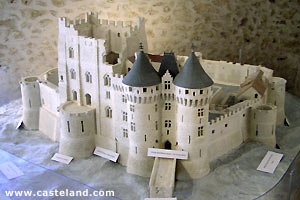|
History of the castle

1 - Beginning of
Xe century
911 - Treaty of Saint-Clair
on-Epte. Creation of the duchy of Normandy.
931 - The Norman ones reach Alençon and set fire to Chartres.
The Pole "goes separating" occupies a strategic position
border, because located between the royal field and the territories
occupied by the Norman ones.
2 - Second half
of Xe century
To protect itself from
these terrible neighbors, the count of Chartres, Thibault the Cheater,
vassal on king de France, decides to install in Nogent, in avant-garde,
one of his faithful of the name of ROTROLDUS, in order to take care
of the border. Thus appears in the history, the first lord of Nogent.
Rotrou, whose name was given to its dynasty. On a site, which passes
to have been occupied since antiquity, Rotrou Ier makes rebuild,
probably drink some, a castle with the site of older which would
have been demolished by the Danes.
3
- Beginning XIe century
 Its
successor Geoffroy II fact of building in the years the 1020 keep
hones some that we admire still today. To this time the small bays
in semicircular arch go back which one sees on the last floor. The
keep is established in advanced defensive position. It is protected
in the west by natural defenses; in the east, side plate, a ditch
of a score of meters of broad and deep from seven to eight meters
is spread in half-circle to meet at the place where the plate overhangs
of an about sixty meters the valley of Huisne. Its
successor Geoffroy II fact of building in the years the 1020 keep
hones some that we admire still today. To this time the small bays
in semicircular arch go back which one sees on the last floor. The
keep is established in advanced defensive position. It is protected
in the west by natural defenses; in the east, side plate, a ditch
of a score of meters of broad and deep from seven to eight meters
is spread in half-circle to meet at the place where the plate overhangs
of an about sixty meters the valley of Huisne.
In 1028, the Saint-Denis abbey is rested by Geoffroy III, frightening
warrior, as a sign of repentance. The charter of foundation, written
in 1031, locates the abbey "between Huisne and the strong castle
of Nogent". It is the first time that in a charter the existence
of the castle appears. In 1079, the lords of Nogent take the title
of counts of the Pole. In 1100, Rotrou III learns death from his/her
father, Geoffroy IV, first count of the Pole, whereas it takes part
in the head office of Jerusalem (1099), at the time of the first
crusade.
4 - End XIe in XIIe
century
Between the rides and
the combat, the lords of Nogent live the keep and bring some elements
of comfort there: creation of geminated bays with lancets in slightly
broken arc and bored tympanum of a losangé oculus, construction
of chimneys.
Between 1100 and 1144, Rotrou III, known as the Large one, leaves
with six recoveries its grounds of the Pole to go guerroyer against
the Arabs, to Spain and Holy Land. At the time of its briefs returns
on its native soil, it takes an active share, at the sides of the
duke of Normandy, king d' Angleterre, with the competitions with
the king of France, for which Robert the Devil fights, lord of Bellême.
In 1113, it receives Bellême of Henri it, Beauclerc, in reward
of its services. With its death, Rotrou III leaves a powerful, sovereign
and independent county.
In the medium of XIIe century, buttresses come to reinforce the
four angles of the keep, as well as the faces is, southern and western.
Between 1144 and 1191, Rotrou IV takes an active part in the conflict
which always opposes France and England. In 1191, it finds death
under the walls of Saint Jean-to Acre in Palestine.
5 - End XIIe at
the beginning XIVe century
The military architecture
changes radically: influence that of the Close East, creation of
a military body of engineers by Philippe Auguste. In 1204, Philippe-Auguste
conquers Normandy and confiscates it with Jean-Without-Ground. The
county of the Pole loses thus its character of frontier zone.
In 1217, Thomas, 5th count of the Pole, is killed with the battle
of Lincoln on May 20, 1217. The crown prince Louis VIII, wire of
Philippe-Auguste, of "felt the greatest pain".
In 1226, the Pole is plain with the crown of France. To XIIIe and
XIVe centuries, no significant modification is made to the fortress.
Next
page
|




 Its
successor Geoffroy II fact of building in the years the 1020 keep
hones some that we admire still today. To this time the small bays
in semicircular arch go back which one sees on the last floor. The
keep is established in advanced defensive position. It is protected
in the west by natural defenses; in the east, side plate, a ditch
of a score of meters of broad and deep from seven to eight meters
is spread in half-circle to meet at the place where the plate overhangs
of an about sixty meters the valley of Huisne.
Its
successor Geoffroy II fact of building in the years the 1020 keep
hones some that we admire still today. To this time the small bays
in semicircular arch go back which one sees on the last floor. The
keep is established in advanced defensive position. It is protected
in the west by natural defenses; in the east, side plate, a ditch
of a score of meters of broad and deep from seven to eight meters
is spread in half-circle to meet at the place where the plate overhangs
of an about sixty meters the valley of Huisne. 
